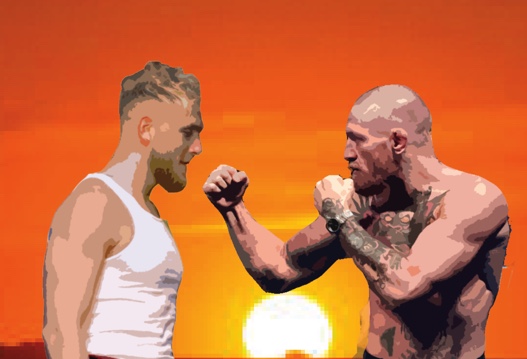The World of Combat Sports: Boxing vs MMA
Combat sports are no place for the weak of heart. Traditionally, when fighters step into the ring or the Octagon, they enter a battle of life and death. Two of the most well-known combat sports are boxing and mixed martial arts (MMA). While in recent years MMA has remained competitive and loaded with fierce rivalries, boxing has undergone a transition from focusing on pure competition to only revolving around entertainment and money. In this story, Viking dives into the world of combat sports, analyzing their current and former states.

March 1, 2021
Within the Ropes:
A packed arena overflow with raucous fans crowded around a 20 by 20-foot square ring. Entrapped within the ring’s ropes stand two glove-clad fighters, mercilessly trading blows. The sounds of the gloves hitting home on the opponent’s body are drowned out by the electrifying screams of the crowd. A true test of strength, character, and toughness, boxing combines world-class athletes, brutal combat, and engrossing entertainment like no other sport.
Boxing has been a popular sport for hundreds of years, taking root in the U.S. in the late 1700s. However, it was not until the rise of the legendary Muhammad Ali that the sport became a worldwide phenomenon, drawing fans of all ages, backgrounds, and nationalities. Ali began his boxing journey at age 12 when he vowed to take physical revenge on the man who stole his bicycle. This single, seemingly insignificant incident jump-started Ali’s amateur boxing career, which saw him gain 100 wins and wins two national Golden Glove titles by the time he was 18. Ali’s pro career resulted in 56 wins, 5 losses, and 37 knockouts, and his fights drew global appeal as well as helped bring about the “golden age of boxing” in the 1960s. Despite the money and fame that he gained, Ali remained humble and true to the sport’s core principles, as he fought for honor and respect.
“The golden age of boxing” brought about by Ali’s legendary career led to a mass popularization of the sport, and the rise of new, younger, stars. One of these stars was Mike Tyson, who began his career vowing to avenge an Ali loss by defeating the same man who bested Ali. At first, Tyson fought for the same reasons that Ali and other boxers of his era did — the principles of dignity, respect, and honoring the game still reigned supreme. However, as Tyson rose through the ranks and rapidly gained fame through his brutally quick and vicious knockouts, his motives changed. “Iron Mike” became entranced by money and fame, evidence of a clear shift in the sport of boxing. Opposed to the foundational morals of boxing, the sport increasingly became more about the paycheck and the flashing lights than anything else.
After Tyson and the boxing culture transition of the 1990s, the boxers that followed represented a mix of the old and new customs. Some of the most successful of these new-age boxers were Manny Pacquiao and Floyd “Money” Mayweather, who currently has an undefeated record of 50-0. These boxers fought and still fight with the purpose of preserving their legacies and gaining respect, but also for the money, fame, and notoriety that comes with pro boxing.
The culture of boxing has clearly undergone serious changes since its inception. The boxing climate of today is significantly different from the respective eras of Muhammad Ali, Mike Tyson, and Floyd Mayweather. This can largely be attributed to the rise of “celebrity boxing.” What started as a way for YouTubers to settle online disputes by hashing it out in the ring has now created a completely new face for boxing. This revolution of entertainers who declare themselves “professional boxers” gained popularity when famous online personalities Logan Paul and KSI stepped in the ring for a 2018 bout that was purely for entertainment. A year later, a rematch between the two sold out the 20,000 person capacity Staples Center. It became clear that the legitimacy of boxing had taken a complete turn. Instead of training, skilled fighters battling it out for glory, seemingly anyone with a name and following could enter the ring to attract fame and money. Boxing was now more than ever an industry revolving around entertainment, where people tuned into fights merely for the fighters and not the game itself.
A few years after the upsurge of celebrity boxing, the sport’s culture continues to shift towards entertainment. What was previously a battle of gladiators has now increasingly become an engine for creating and settling social media disputes. A key stimulator of this new trend of boxing has been Jake Paul, an extremely controversial YouTuber and social media personality. Unlike many of the professional boxers who came before him, Paul has minimal training and experience and utilizes his name and wealth to generate popularity for fights. Last November, Paul and former NBA star Nate Robinson brought their online feud into the ring, fighting as the co-main event to the return of Mike Tyson. At the time, Paul was 1-0 in “professional” boxing matches, while Robinson only had a few months of limited fighting experience. Paul brutally knocked out Robinson early in the second round, effectively breaking the internet and sending waves through the boxing world. While it is customary for fighters to win graciously, Paul took his win over an underskilled and inferior opponent and claimed that he was “the biggest prizefighter on the planet”. He then proceeded to call out big-name fighters, notably Conner McGregor and his understudy Dillon Danis, to fight him, a bold move for a fighter with a single professional win.
Paul’s antics represent the difference between the current state of boxing and the sport of old. Instead of fighters being humble and competing for their love of the game, many of the fighters of today, like Paul, only enter the ring to generate must-see TV and leave with a bag of money. The boxing and entertainment industries have become increasingly intertwined, begging the question of how long it will be until the original core principles of boxing disappear – forever.
Competition Between the Cage:
At the same time that Mike Tyson was becoming the most feared man in boxing, another combat sport was in its infancy. In 1993, while Mike Tyson was in jail plotting his comeback, the UFC held its first event. In the 28 years since the UFC and Mixed Martial Arts (MMA) have steadily grown into a global phenomenon. Although boxing still generates more revenue, MMA is on a fast track to eclipse its combat sport counterpart and is already the leader in terms of pure competition within combat sports. But the question is, why?
January 23: the return of Connor McGregor, one of the most polarizing figures in all of professional athletics. The fight, pitting McGregor against Dustin Poirer, reportedly tied for the second-most pay-per-view buys in UFC history. However, it did not go as planned for McGregor. Poirer employed a masterful strategy, utilizing low calf kicks, to systematically dismantle McGregor before handing him the first knockout loss of his career. While shocking, the aftermath of McGregor’s stunning defeat helps highlight the differences in boxing and MMA culture.
In every competitive sport, the loss is an accepted part of the game. In most sports, a team’s record is reset at the end of the season and they begin the next year 0-0. This acts as a way to give these teams a new beginning. In combat sports, however, a fighter’s record lives on with them for their entire career. If a fighter loses their first fight, years before they even reach a major promotion like the UFC or Bellator, that loss will always be displayed on their record.
In MMA, fans understand that loss is a natural byproduct of competition. Half of the fighters on the card will take a loss on any given Saturday. It is accepted that fighters don’t have a chance to “reset” their records like in other pro sports. In boxing though, this simple rule of competition is not accepted. If a fighter takes even a single loss, promoters will blacklist them, and the fans will no longer tune-in. To remain relevant following the defeat, a boxer must already have already been competing for world championships.
Because of boxing’s inability to accept failures, promoters will take promising young fighters and get them 20 fights with untalented opponents, just to pump them up to a perfect 20-0 record. This number, 20-0, is the unspoken standard at which a promoter can now create a sense of false legitimacy around an athlete and market them as “the next big thing.” This destroys any sort of competitive architecture that would allow fighters to rise through the ranks and establish a clear and fair pecking order. With the so-called “best” fighters refusing to risk their “0” in the loss column, boxing is unable to match up to its best fighters and show who’s truly at the top of the sport.
However, this standard isn’t true in w. Coming into January 23rd, Connor McGregor had a record of 22-4. Jorge Masvidal, the 2019 fighter of the year, currently holds a professional record of 35-14-2. In fact, only one fighter in the history of the sport has ever been deemed to have an undefeated record: Khabib Nurgadamedov.
So why does all this matter? In short, by allowing competitors to remain relevant even in defeat, MMA can put on the most competitive fights available within the sport, because fighters do not fear that defeat will lose their livelihoods.
One thing MMA and Boxing have in common is the card system. The card is the series of fights that happen at a given event, culminating in the main event. Both sports also employ an undercard, consisting of lesser-known, younger fighters. The undercard is made up of three fights but is rarely watched. When it comes to fighter pay, the disparity only grows. Figures can be even more lopsided with the two fighters in the main event walking away with up to 70 times as much cash as the six undercard fighters combined.
When so little attention is paid to the undercard, it’s hard to build up the sport’s next crop of talent. MMA understands that to build for the future, their young fighters need a platform. The average UFC card has 14 bouts, 8 on the “prelims” or undercard, and 6 on the main card. With more opportunities to be seen by fans, even the casual viewer can’t help but pick up the names of a few up-and-coming fighters, making it that much easier for MMA to develop new stars.
In the world of professional athletics, the pay-per-view model is used only by combat sports. In essence, a fan has to pay a fee for every event they would like to watch. Boxing and MMA pay per view range from $50-100 dollars for a given event. Considering this is a pretty hefty price tag for just one night’s worth of entertainment, it can be hard to draw in new fans. In boxing, every single notable event (with a few exceptions) is a pay-per-view. In MMA, pay-per-view events happen at most once per month, with quality fights being live-streamed at least 2-4 times a month.
The net of this all is that once again, MMA is able to get more eyes on their product. Casual fans can be more easily indoctrinated into the sport, picking out fighters to root for without having to pay exorbitant fees to see them.
All told, boxing and MMA are the two premier professional combat sports. Will boxing fans still tune in to watch true competitors like Canelo, Fury, Wilder, and Crawford? Yes, undoubtedly so. But in the modern era of boxing, the new viewers’ first experience with the sport is much more likely to be the product of yet another experiment with celebrity boxing. Although in the short term this might be profitable, it is not a sustainable business model for long-term industry growth. MMA’s ability to learn from some of boxing’s pitfalls, like undervaluing prelim fights, or not forgiving fighters for losses, has allowed the sport to continue down the path of competitiveness. Because fighters compete against the best and have a spotlight even as rookies, MMA is able to build for the future and put itself on track to become the world’s leading combat sport.









Dillon • May 16, 2021 at 4:43 am
Great article. Made good points